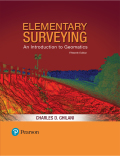
Concept explainers
(b)
The definition of subdivision
(b)
Explanation of Solution
Subdivision survey is a method in which a larger land which is already surveyed is divided into smaller segments. The land can be divided in one or two segments only. This type of survey is useful when a new city or town is planned.
A closed traverse including all the corners is considered and furthermeasurements are carried out.
(c)
The definition of practical location.
(c)
Explanation of Solution
Practical location is an equity which allows the parties to fix the location of their boundary that is different from the boundary mentioned by the surveyor.
The general conditions for a practical location are:
- The record boundary should be unknown.
- The boundary should be fixed by walls, building lines, fences or monuments.
- The parties in interest should assure that the boundary so located is accepted and recognized.
(d)
The definition of adverse possession.
(d)
Explanation of Solution
Adverse possession is a legal process to gain ownership of the property by occupying the land or a part of the land based on thehistory of possession or the use of land without the permission of the owner.
A part of theneighbor’s land, street or footpath can be claimed if it has been used continuously for many years.
Want to see more full solutions like this?
Chapter 21 Solutions
EBK ELEMENTARY SURVEYING
- Q3: The scanning process was completed from point F to point G. The direction of the line Fl and the angles of deviation and interior are shown in the figure below. Find the direction of the remaining sides? Azimn = 60° F 52° 52° 72° R= 572.958/D ° T-R tan(A/2) • LC 2R sin (A/2) • E-R (sec(A/2)-1) • M-R (1-cos (A/2)) L= 10 A/D •C=2R sin(2D/2) • d=Dc/10 c' 2R sin (d/2) • Y= √√R2-X2-K • K= R2- K=R-M G H معادلات :مفيدةarrow_forwardPlease write me Background Reviews;arrow_forwardQ1/ The specific gravity of the soil is 1.41 percentage of water content by weight at field capacity and wilting point are 15% and 7% respectively calculate the equivalent moisture content as equivalent depth for 1.2m root zone : 1. at permanent wilting point 2. at field capacity 3. for ready available waterarrow_forward
- Kindy explain the pie chart percentage and give some related study and references about Value of travel time connected to the pie chartarrow_forwardConsider the specifications for an asphaltic concrete mixture and the results of a sieve analysis below. Coarse aggregates: Fine aggregates: Filler: 60% 35% 5% Percent of Weight of Aggregate or Filler Passing Sieve Designation Retained on Sieve Designation Coarse Aggregate Fine Aggregate Mineral Filler 3/4 in. (19 mm) 1/2 in. 6 1/2 in. (12.5 mm) 3/8 in. 15 3/8 in. (9.5 mm) No. 4 50 - No. 4 (4.75 mm) No. 10 20 1 No. 10 (2 mm) No. 40 (0.425 mm) No. 40 9 35 - No. 80 31 40 No. 80 (0.180 mm) No. 200 (0.075 mm) Total No. 200 - 33 - - 25 35 100 100 100 Determine the proportion of different aggregates to obtain the required gradation. Percent of Total Weight of Mixture Passing Sieve Designation Retained on Sieve Designation Coarse Aggregate Fine Aggregate 3/4 in. (19 mm) 1/2 in. (12.5 mm) 3/8 in. (9.5 mm) 1/2 in. 3/8 in. No. 4 No. 4 (4.75 mm) No. 10 No. 10 (2 mm) No. 40 No. 40 (0.425 mm) No. 80 No. 80 (0.180 mm) No. 200 No. 200 (0.075 mm) Total Need Help? Read It Mineral Filler Total 100arrow_forwardResults obtained from laboratory tests on a sample of RC-250 asphalt cement are given. Determine whether the properties of this material meet the Asphalt Institute specifications for this type of material; if not, note the differences. (For each specification, enter the minimum acceptab value in the same units as used in the test results.) • Kinematic viscosity at 140°F (60°C) = 230 centistokes • Flash point (Tagliabue open cup) = 89°F • Distillation test where distillate percent by volume of total distillate to 680°F (360ºC) • To 437°F (225°C) = 27% • To 500°F (260°C) = 69% • To 600°F (316°C) = 72% • Residue from distillation to 680°F (360°C) by volume percentage of sample by difference • Tests on Residue from Distillation: • Ductility at 77°F (25°C) = 92 cm • Absolute viscosity at 140°F (60°C) = 620 poises ⚫ Solubility = 90% Property Kinematic Viscosity = 74% Specification Test Results Were Specifications Met? centistokes 230 centistokes ---Select--- ✓ Flash Point °F 89°F…arrow_forward
- Problem 2 Two machines produce rivets for a factory job. The number of sub-standard rivets per hour by the two machines are random variables, denoted by X1 and X2. The bivariate PMF of X1 and X2, Px,x,(x1,x2), is given in the table below. X2=0 X2=1 X2=2 X2=3 X₁-0 0.07 0.05 0.02 0.01 X₁ =1 0.05 0.16 0.12 0.02 X₁ =2 0.02 0.12 0.17 0.05 X₁ =3 0.01 0.01 0.05 0.07arrow_forwardPlease provide a handwritten solution to the questionarrow_forwardPlease solve the question by hand with a detailed explanation of the steps.arrow_forward
- Please provide a handwritten solution to the questionarrow_forwardplease helparrow_forwardAS Q1/ The specific gravity of the soil is 1.41 percentage of water content by weight at field capacity and wilting point are 15% and 7% respectively calculate the equivalent moisture content as equivalent depth for 1.2m root zone : 1. at permanent wilting point 2. at field capacity 3. for ready available waterarrow_forward

 Structural Analysis (10th Edition)Civil EngineeringISBN:9780134610672Author:Russell C. HibbelerPublisher:PEARSON
Structural Analysis (10th Edition)Civil EngineeringISBN:9780134610672Author:Russell C. HibbelerPublisher:PEARSON Principles of Foundation Engineering (MindTap Cou...Civil EngineeringISBN:9781337705028Author:Braja M. Das, Nagaratnam SivakuganPublisher:Cengage Learning
Principles of Foundation Engineering (MindTap Cou...Civil EngineeringISBN:9781337705028Author:Braja M. Das, Nagaratnam SivakuganPublisher:Cengage Learning Fundamentals of Structural AnalysisCivil EngineeringISBN:9780073398006Author:Kenneth M. Leet Emeritus, Chia-Ming Uang, Joel LanningPublisher:McGraw-Hill Education
Fundamentals of Structural AnalysisCivil EngineeringISBN:9780073398006Author:Kenneth M. Leet Emeritus, Chia-Ming Uang, Joel LanningPublisher:McGraw-Hill Education
 Traffic and Highway EngineeringCivil EngineeringISBN:9781305156241Author:Garber, Nicholas J.Publisher:Cengage Learning
Traffic and Highway EngineeringCivil EngineeringISBN:9781305156241Author:Garber, Nicholas J.Publisher:Cengage Learning





